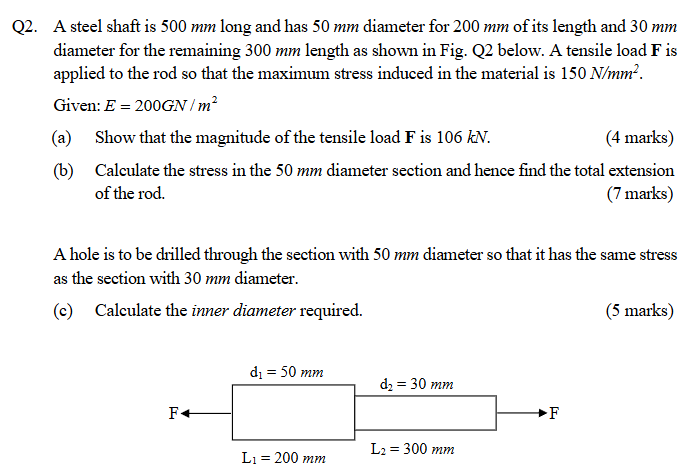A steel shaft is 500 mm long and has 50 mm diameter for 200 mm of its length and 30 mm diameter for the remaining 300 mm length. A tensile load F is applied to the rod so that the... A steel shaft is 500 mm long and has 50 mm diameter for 200 mm of its length and 30 mm diameter for the remaining 300 mm length. A tensile load F is applied to the rod so that the maximum stress induced in the material is 150 N/mm². Given: E = 200GN/m². (a) Show that the magnitude of the tensile load F is 106 kN. (b) Calculate the stress in the 50 mm diameter section and hence find the total extension of the rod. (c) A hole is to be drilled through the section with 50 mm diameter so that it has the same stress as the section with 30 mm diameter. Calculate the inner diameter required.

Understand the Problem
The question involves a steel shaft with varying diameters subjected to a tensile load. It asks us to verify the magnitude of the tensile load, calculate the stress and extension in a specific section, and determine the required inner diameter of a hole to be drilled such that it withstands the same stress.
Answer
(a) $F = 106.03 \text{ kN}$ (b) $\sigma_1 = 54 \text{ N/mm}^2$, $\Delta L_{total} = 0.279 \text{ mm}$ (c) $d = 40 \text{ mm}$
Answer for screen readers
(a) The magnitude of the tensile load $F$ is $106.03 \text{ kN}$ (approximately $106 \text{ kN}$). (b) The stress in the 50 mm diameter section is $54 \text{ N/mm}^2$, and the total extension of the rod is $0.279 \text{ mm}$. (c) The inner diameter required is $40 \text{ mm}$.
Steps to Solve
- Calculate the area of the smaller diameter section
The smaller diameter section has the maximum stress. Calculate the area $A_2$ using the formula for the area of a circle: $A = \pi r^2 = \pi (\frac{d}{2})^2$ Given $d_2 = 30 \text{ mm}$, $A_2 = \pi (\frac{30}{2})^2 = \pi (15)^2 = 225\pi \text{ mm}^2$
- Calculate the tensile load $F$
We know that stress $\sigma = \frac{F}{A}$. Therefore, $F = \sigma \times A$. The maximum stress $\sigma_{max} = 150 \text{ N/mm}^2$ occurs in the smaller diameter section. $F = \sigma_{max} \times A_2 = 150 \text{ N/mm}^2 \times 225\pi \text{ mm}^2 = 33750\pi \text{ N} \approx 106028.75 \text{ N}$ Convert Newtons to kilonewtons: $F \approx 106.03 \text{ kN}$ This confirms that the tensile load $F$ is approximately $106 \text{ kN}$.
- Calculate the stress in the larger diameter section
Calculate the area of the larger diameter section. Given $d_1 = 50 \text{ mm}$, $A_1 = \pi (\frac{50}{2})^2 = \pi (25)^2 = 625\pi \text{ mm}^2$ Calculate the stress in the $50 \text{ mm}$ diameter section: $\sigma_1 = \frac{F}{A_1} = \frac{33750\pi}{625\pi} = \frac{33750}{625} = 54 \text{ N/mm}^2$
- Calculate the extension of the rod in the larger diameter section
Use the formula for extension, $\Delta L = \frac{FL}{EA}$. For the larger diameter section: $F = 33750\pi \text{ N}$, $L_1 = 200 \text{ mm}$, $E = 200 \text{ GN/m}^2 = 200 \times 10^3 \text{ N/mm}^2$, and $A_1 = 625\pi \text{ mm}^2$ $\Delta L_1 = \frac{33750\pi \times 200}{200 \times 10^3 \times 625\pi} = \frac{33750 \times 200}{200 \times 10^3 \times 625} = \frac{6750000}{125000000} = 0.054 \text{ mm}$
- Calculate the extension of the rod in the smaller diameter section
For the smaller diameter section: $F = 33750\pi \text{ N}$, $L_2 = 300 \text{ mm}$, $E = 200 \times 10^3 \text{ N/mm}^2$, and $A_2 = 225\pi \text{ mm}^2$ $\Delta L_2 = \frac{33750\pi \times 300}{200 \times 10^3 \times 225\pi} = \frac{33750 \times 300}{200 \times 10^3 \times 225} = \frac{10125000}{45000000} = 0.225 \text{ mm}$
- Calculate the total extension
The total extension is the sum of the extensions in both sections: $\Delta L_{total} = \Delta L_1 + \Delta L_2 = 0.054 + 0.225 = 0.279 \text{ mm}$
- Calculate the inner diameter required
The stress in the section with the hole should be the same as the stress in the 30 mm diameter section, which is $150 \text{ N/mm}^2$. Let $d$ be the inner diameter of the hole. The area of the section with the hole is $A_{hole} = \pi (\frac{50}{2})^2 - \pi (\frac{d}{2})^2 = \pi (25^2 - (\frac{d}{2})^2) = \pi (625 - \frac{d^2}{4})$ Since the stress is the same, we have: $\sigma = \frac{F}{A_{hole}} = 150 \text{ N/mm}^2$ $150 = \frac{33750\pi}{\pi (625 - \frac{d^2}{4})} = \frac{33750}{625 - \frac{d^2}{4}}$ $150 (625 - \frac{d^2}{4}) = 33750$ $625 - \frac{d^2}{4} = \frac{33750}{150} = 225$ $\frac{d^2}{4} = 625 - 225 = 400$ $d^2 = 400 \times 4 = 1600$ $d = \sqrt{1600} = 40 \text{ mm}$
(a) The magnitude of the tensile load $F$ is $106.03 \text{ kN}$ (approximately $106 \text{ kN}$). (b) The stress in the 50 mm diameter section is $54 \text{ N/mm}^2$, and the total extension of the rod is $0.279 \text{ mm}$. (c) The inner diameter required is $40 \text{ mm}$.
More Information
The stress is inversely proportional to the cross-sectional area. Therefore, a smaller area results in a larger stress for the same force. The extension is directly proportional to the force and length, and inversely proportional to the Young's modulus and area.
Tips
- Units Conversion: Failing to convert units consistently (e.g., mm to meters) can lead to incorrect answers. Ensure all units are consistent before performing calculations.
- Area Calculation: Using the diameter instead of the radius when calculating the area of the circular cross-sections.
- Stress Calculation: Incorrectly applying the formula for stress (e.g., dividing area by force instead of force by area).
AI-generated content may contain errors. Please verify critical information